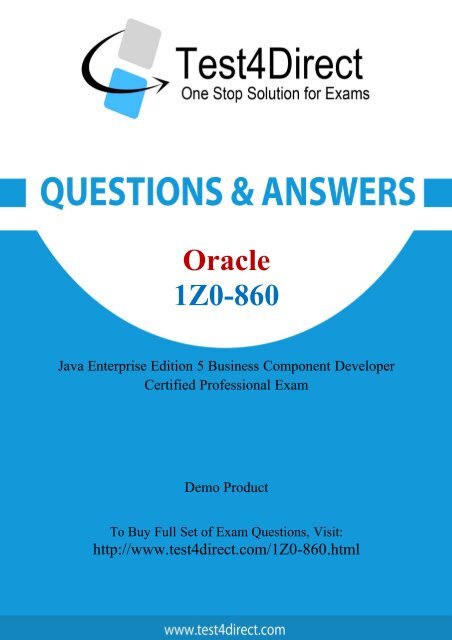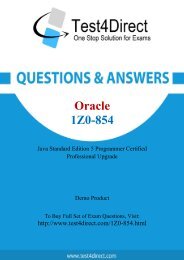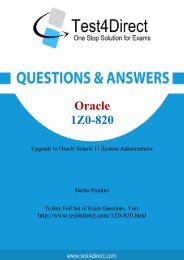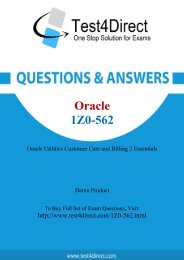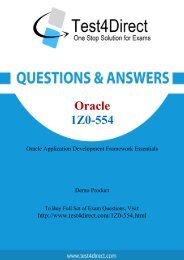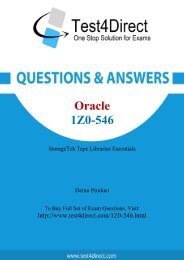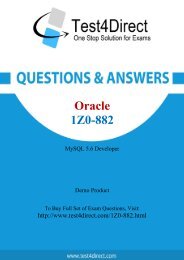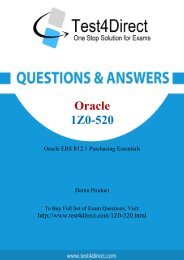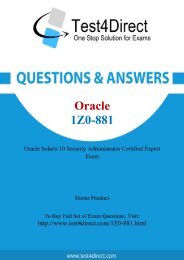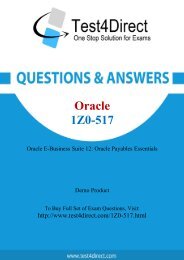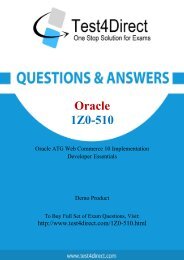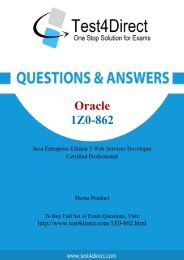1Z0-860-demo
You also want an ePaper? Increase the reach of your titles
YUMPU automatically turns print PDFs into web optimized ePapers that Google loves.
Oracle<br />
<strong>1Z0</strong>-<strong>860</strong><br />
Java Enterprise Edition 5 Business Component Developer<br />
Certified Professional Exam<br />
Demo Product<br />
To Buy Full Set of Exam Questions, Visit:<br />
http://www.test4direct.com/<strong>1Z0</strong>-<strong>860</strong>.html
Question: 1<br />
Given the following stateful session bean:<br />
10. @Stateful<br />
11. @TransactionAttributefJransactionAttributeType. SUPPORTS)<br />
12. public class VideoBean implements Video {<br />
13. // insert code here<br />
14. public void methodAO {}<br />
15.}<br />
Assuming no other transaction-related metadata, which code can be added at Line 13 to guarantee<br />
that business method methodA will execute only if invoked with an active transaction?<br />
A. @TransactionAttributefJ<br />
B. @TransactionManagement(TransactionAttributeType. CONTAINER)<br />
C. @TransactionAttribute(TransactionAttributeType.MANDATORY)<br />
D. @TransactionAttributeO"ransactionAttributeType.REQUIRES_NEW)<br />
Question: 2<br />
Given the following client-side code that makes use of the session bean Foo:<br />
10. @EJB Foo beanl;<br />
11. @EJB Foo bean2; //more code here<br />
20. booleantestl = beanl.equals(beanl);<br />
21. booleantest2 = beanl.equals(bean2);<br />
Which two statements are true? (Choose two.)<br />
A. If Foo isstateful,testlistrue, and test2 is true.<br />
B. IfFoo is stateful, testlis true,andtest2isfalse.<br />
C. IfFoo is stateless, testl is true, and test2 is true.<br />
D. IfFoois stateful, testl is false, and test2 is false.<br />
E. If Foo isstateless, testl istrue,and test2 is false.<br />
F. If Fooisstateless, testl is false, andtest2is false.<br />
Question: 3<br />
Which statement about entity manager is true?<br />
Answer: C<br />
Answer: B,C<br />
A. A container-managed entity manager must be a JTA entity manager.<br />
B. An entity manager injected into session beans can use either JTA or resource-local transaction<br />
control.<br />
C. An entity manager created by calling the EntityManagerFactory.createEntityManager method<br />
always uses JTA transaction control.<br />
D. An entity manager obtained through resource injection in a stateful session bean can use a
esource-local EntityTransaction for transaction control<br />
Answer: A<br />
Question: 4<br />
Which statement is true about the use of a persist operation in a transaction?<br />
A. If a user persists a detached object it always becomes managed.<br />
B. The persist operation on an entity always cascades to its related entities.<br />
C. If a user persists a new entity with an existing primary key the transaction will fail.<br />
D. If a user persists a managed entity an exception may be thrown by the persist operation.<br />
Question: 5<br />
Question: 6<br />
Question: 7<br />
Answer: C<br />
A developer writes a stateless session bean with one local business interface and with containermanaged<br />
transactions. All business methods have transaction attribute REQUIRED. The bean has an<br />
injected field sessionCtx of the type SessionContext. Which two operations are allowed in a business<br />
method of the bean? (Choose two.)<br />
A. sessionCtx. getEJBObject<br />
B. sessionCtx.setRollbackOnly<br />
C. sessionCtx. getMessageContext<br />
D. sessionCtx. getBusinessObject<br />
E. sessionCtx. getEJBLocalObject<br />
Answer: B,D<br />
A developer implements a session bean with a method doStuff which behaves differently depending<br />
on the caller's security role. Only users in security roles "ADMIN" and "USER" are allowed to call the<br />
method. Assume that there is no security-related metadata in the deployment descriptor. Which<br />
two, taken in combination, are appropriate to accomplish this? (Choose two.)<br />
A. Annotate method doStuff with @PermitAII.<br />
B. AnnotatemethoddoStuff with@RolesAllowed({"ADMIN","USER"})<br />
C. If EJBContext.getCallerPrincipal returns role "ADMIN", implement thebehaviorfor users in role<br />
ADMIN.<br />
D. If EJBContext.isCallerlnRole("ADMIN") returns true, implement the behavior defined for users in<br />
role "ADMIN".<br />
Answer: B,D<br />
Which Java Persistence query uses the aggregate function correctly, assuming that chairs field is of
type int?<br />
A. SELECT ANY(r. chairs) FROM Room r<br />
B. SELECT NEW Integer(MAX(r. chairs)) FROM Room r<br />
C. SELECT r FROM Room r WHERE r.chairs > AVG(r.chairs)<br />
D. SELECT c FROM Chair c WHERE LOCATE (c.type, lazyboy) > -1<br />
Answer: B<br />
Question: 8<br />
Given:<br />
11.©Entity public class X{<br />
12. @ld int id;<br />
13. Y y;<br />
14.}<br />
A public class Y with NO Java Persistence annotations is defined in the same package. Which<br />
statement is correct about these classes if NO other annotations and mapping descriptors are<br />
provided?<br />
A. Class Y must be serializable.<br />
B. ClassYmust be marked as an entity.<br />
C. The entity X is notdefinedcorrectly.The field y must be marked as @Lob.<br />
D. ClassY must be accessedbyapersistenceapplication throughapublicinterface.<br />
Question: 9<br />
Question: 10<br />
Answer: A<br />
A developer creates a stateless session bean. This session bean needs data from a remote system.<br />
Reading this data takes a long time. Assume that the data will NOT change during the lifetime of the<br />
bean and that the information to connect to the remote system is defined in JNDI. Which statement<br />
describes how to manage the data correctly?<br />
A. Readthe datain the bean's constructor.<br />
B. The datacan only bereadinthebean's business methods.<br />
C. Read thedatain a method which is annotated with@PrePassivate.<br />
D. Read the data in a method which is annotated with @Post Activate.<br />
E. Readthedata ina methodwhich is annotated with (5)PostConstruct.<br />
Answer: E<br />
An enterprise bean has security permissions set up using declarative security features. Under which<br />
two conditions can a client be guaranteed to have permission to invoke a business method on the<br />
enterprise bean? (Choose two.)<br />
A. The Application Assembler has marked the enterprise bean methodasunchecked.
B. The client's principalhas beenassigned a securityrolewithpermissionto invokethe method.<br />
C. The Application Assembler has set the security-identity deployment descriptor to run-as.<br />
D. TheApplicationAssemblerhas mapped all security role references using the role-link element.<br />
Question: 11<br />
Question: 12<br />
Answer: A,B<br />
An enterprise developer needs to modify the order of interceptor method execution specified by the<br />
Bean Provider, but does NOT have access to the bean's source code. No deployment descriptor was<br />
provided in the ejb-jar delivered by the Bean Provider. Which represents the solution to this<br />
problem?<br />
A. No solution is possible under these conditions.<br />
B. TheDeployer canadd metadataannotations totheejb-jar.<br />
C. The Application Assembler can add metadata annotations to the ejb-jar.<br />
D. TheSystem Administrator can addinterceptorbinding informationatruntime, using vendorspecific<br />
tools.<br />
E. TheApplication Assembler canaddadeployment descriptor totheejb-jarthat includesinterceptor<br />
binding information.<br />
Question: 13<br />
Answer: E<br />
A developer writes a session bean which uses several configurable constants. The constants are all<br />
defined as String types in JNDI. This cannot be changed because existing code is using the same JNDI<br />
information. One of the constants is a date, represented in string format. This date constant is used<br />
in multiple business methods of this session bean, actually as a Date object. Converting strings to<br />
dates is an expensive operation; therefore, the developer wants to do as little converting as possible.<br />
Which two scenarios can be used to prevent converting from String to Date in every business<br />
method? (Choose two.)<br />
A. Loadthe date string in an instance Date type variablebyannotation of the instance variable and let<br />
the container autoconvert it to a Datetypeautomatically.<br />
B. Load thedate string in an instance String type variablebyannotation of this instance<br />
variableandconvertitto aDatetype object in the beans constructor.<br />
C. Load thedatestringinaninstanceString typevariableby annotationof this instance variable and<br />
convert it to aDate typeobjectin a@PostConstructannotatedmethod.<br />
D. Load the date string in an instance Date typevariableby annotation ofasetter method that takes a<br />
String and which carries out the conversion and assigns the value totheinstance variable.<br />
Which is a valid PostConstruct method in a message-driven bean class?<br />
A. ©PostConstruct<br />
Answer: C,D
public boolean initQ {return true; }<br />
B. ©PostConstruct private static void init0 {}<br />
C. ©PostConstruct private void init0 {}<br />
D. ©PostConstruct public static void initQ {}<br />
Answer: C<br />
Question: 14<br />
A developer wants to create a JMS message-driven bean that responds to javax.jms.TextMessage<br />
messages. Which two statements are true? (Choose two.)<br />
A. The developer must implement the ejbCreate method.<br />
B. The developer does NOT need to create a business interface for the bean.<br />
C. The developer must implement a method that declares javax.jms.TextMessage as an argument.<br />
D. The message-driven bean class must implement methods of the javax.jms.MessageListener<br />
interface.<br />
E. The message-driven bean class must implement methods of the javax. ejb. MessageDnvenBean<br />
interface.<br />
Question: 15<br />
Question: 16<br />
Answer: B,D<br />
A Reader entity has a one-to-many, bidirectional relationship with a Book entity. Two Reader entities<br />
are persisted, each having two Book entities associated with them. For example, readeM has booka<br />
and bookb, while reader2 has bookc and bookd. Which query returns a Collection of fewer than four<br />
elements?<br />
A. SELECT b.reader FROM Book b<br />
B. SELECT r FROM BookbINNER JOINb.readerr<br />
C. SELECTrFROM Reader r INNER JOIN r.booksb<br />
D. SELECTrfrom BookbLEFT JOIN b.readerr LEFTJOINFETCHr.books<br />
Answer: C<br />
A session bean's business method throws an exception during execution. Which two are<br />
responsibilities of the Bean Provider when throwing the exception? (Choose two.)<br />
A. For application exceptions, ensure that if the current transaction commits there will be no loss of<br />
data integrity.<br />
B. For application exceptions, ensurethatthe current transaction will commit.<br />
C. For system errors, when the client is remote, throw a java.rmi.RemoteException that wraps the<br />
original exception.<br />
D. For checked exceptions from which the bean cannot recover, throw an EJBException that wraps<br />
the original exception.
Answer: A,D<br />
Question: 17<br />
The ejb-jar file format is a contract between which two EJB role pairs? (Choose two.)<br />
A. Deployer and System Administrator<br />
B. Application Assembler and Deployer<br />
C. Bean Provider and Application Assembler<br />
D. Bean Provider and EJB Container Provider<br />
E. EJB Server Provider and EJB Container Provider<br />
F. Application Assembler and EJB Container Provider<br />
Question: 18<br />
Question: 19<br />
Question: 20<br />
Answer: B,C<br />
Which Java Persistence query uses the aggregate function correctly, assuming that chairs field is of<br />
type int?<br />
A. SELECT ANY(r. chairs) FROM Room r<br />
B. SELECT NEW Integer(MAX(r. chairs)) FROM Room r<br />
C. SELECT r FROM Room r WHERE r.chairs > AVG(r.chairs)<br />
D. SELECT c FROM Chair c WHERE LOCATE (c.type, lazyboy) > -1<br />
Answer: B<br />
A developer writes a stateful session bean called FooBean. Which code can be inserted before Line<br />
11 of the FooBean class to define a TYPE-level environment dependency on a JMS Topic?<br />
11. public class FooBean {<br />
12.<br />
13. public void fooQ {}<br />
14.<br />
15.}<br />
A. @Resource(type=Topic. class)<br />
B. @Resource(name="topicRef) private static Topic topic;<br />
C. ©ResourceprivateTopic topic;<br />
D. @Resource(name="topicRef', type=Topic. class)<br />
Answer: D<br />
A developer has created an application-managed entity manager. Which statement is correct?<br />
A. A new persistence context begins when the entity manager is created.
B. A new persistence context begins when a new JTA transaction begins.<br />
C. A new persistence context begins when the entity manager is invoked in the context of a JTA<br />
transaction.<br />
D. A new persistence context begins when the entity manager is invoked in the context of a resourcelocal<br />
transaction.<br />
Question: 21<br />
Question: 22<br />
Answer: A<br />
Given this Java EE application that uses a JTA application-managed entity manager:<br />
20. UserTransaction utx = ...;<br />
21. utx.beginQ;<br />
22. // insert code here<br />
23. utx.commitQ;<br />
Which two code fragments can be used on Line 22 to persist an order instance assuming that all<br />
references are properly initialized? (Choose two.<br />
A. em.merge(order); em.flushQ;<br />
B. em.persist(order); em.flushO;<br />
C. em.joinTransactionO; em.persist(order);<br />
D. em = emfcreateEntityManagerQ; em.persist(order);<br />
Question: 23<br />
Answer: C,D<br />
A developer writes two session beans which cooperate. The first session bean, ShoppingCart, collects<br />
orders and is implemented as a stateful session bean. The second session bean, CalculateDiscount, is<br />
implemented as a stateless session bean and runs on a different server. ShoppingCart contains the<br />
method getTotalPrice, which calculates the total price of the order in the ShoppingCart, including<br />
discounts. Discounts are calculated by CalculateDiscount using the information on the ShoppingCart<br />
bean, combined with data from a database. Which scenario can accomplish this?<br />
A. The CalculateDiscount offers a method calculate which is invoked by the ShoppingCart bean<br />
passing the this reference.<br />
B. The CalculateDiscount offers a method calculate which is invoked by the ShoppingCart bean.<br />
CalculateDiscount accesses the ShoppingCart instance by JNDI lookup.<br />
C. The CalculateDiscount offers a method calculate which is invoked by the ShoppingCart bean<br />
passing its reference obtained from the SessionContext.getBusinessObject method.<br />
D. The CalculateDiscount offers a method calculate which is invoked by the ShoppingCart bean.<br />
CalculateDiscount accesses the state of ShoppingCart by dependency injection.<br />
A CMT session bean named MrBean is annotated as follows :<br />
21. @Stateless(name="MrBean")<br />
Answer: C
22. @TransactionAttribute0"ransactionAttributeType.NOT_SUPPORTED)<br />
23. public class MrBean {<br />
24. public void storeStuffQ {}<br />
25. There are no transaction annotations at the method level.<br />
Given the following snippet of an ejb-jar.xml:<br />
23. <br />
24. <br />
25. MrBean<br />
26. storeStuff<br />
27. <br />
28. Mandatory<br />
29. <br />
Which statement is correct about the business methods in MrBean?<br />
A. All methods have transactionattributeREQUIRED.<br />
B. All methodshavetransaction attributeMANDATORY.<br />
C. All methodshavetransaction attribute NONSUPPORTED.<br />
D. Methods with name store Stuff have transaction attributeMANDATORYand all other methods have<br />
transaction attribute REQUIRED.<br />
E. MethodswithnamestoreStuffhavetransaction attribute MANDATORY andall othermethods have<br />
transaction attribute NONSUPPORTED.<br />
F. Methodswithname store Stuff haveatransaction attribute REQUIRED andallother methods have<br />
transaction attribute NOT SUPPORTED.<br />
Question: 24<br />
Which four are defined in the EJB specification as a standard EJB role? (Choose four.<br />
A. End Point Provider<br />
B. Persistence Provider<br />
C. NameSpace Provider<br />
D. JSF Interface Provider<br />
E. ApplicationAssembler<br />
F. EJBContainerProvider<br />
G. EnterpriseBeanProvider<br />
Question: 25<br />
Answer: E<br />
Answer: B,E,F,G<br />
The syntax of the ORDER BY clause is defined in the Java Persistence API asorderby_clause ::=ORDER<br />
BY orderbyjtem {, orderbyjtem}* Which statement is correct about the use of ORDER BY clauses?<br />
A. Only literals can be specified as an orderbyjtem.<br />
B. Fields or properties of any type can be specified as an orderbyjtem.<br />
C. The ordering must be specified if two or more orderbyjtem methods are provided.<br />
D. If two orderbyjtem methods are provided the left orderbyjtem has the higher precedence.
Answer: D<br />
Question: 26<br />
A developer is writing implementation code for an EJB 3.0 message-driven bean class that processes<br />
booking requests. Within the business logic of the onMessage method, a temporary problem can<br />
occur. In that case the developer wants to make sure that the booking request is processed again in<br />
30 minutes. Which two can the developer select? (Choose two.)<br />
A. Throwa runtimeexception torollbackthetransaction.<br />
B. Call setRollbackOnly on the MessageDrivenContext interface.<br />
C. Makeuseof the TimerService, and implement the TimedObject interface.<br />
D. Make use of the TimerService,implement areprocess method, and annotate it with @Timeout.<br />
E. Throw an application exception, and addtheretry-after attribute to the deployment descriptor.<br />
Question: 27<br />
Question: 28<br />
Answer: C,D<br />
Given a set of CMT bean methods with the following transaction attributes:<br />
Method M1=SUPPORTS<br />
Method M2=REQUIRED<br />
Method M3=NOT_SUPPORTED<br />
Method M4=REQUIRES_NEW<br />
And the following method invocation sequence:<br />
Method M1 invokes Method M2<br />
Method M2 invokes Method M3<br />
Method M1 invokes Method M4<br />
If Method M1 is invoked by a method that does NOT have a transaction context, which describes a<br />
possible scenario?<br />
A. Method M1notransaction<br />
MethodM2new transaction<br />
Method M3no transaction<br />
MethodM4newtransaction<br />
B. Method M1notransaction<br />
Method M2Container throws EJBTransactionRequiredException<br />
C. MethodM1new transaction<br />
Method M2runs in same transaction as M1<br />
Method M3Container throws TransactionNotSupportedException<br />
D. Method M1no transaction<br />
Method M2new transaction<br />
Method M3Container throws TransactionNotSupportedException<br />
Answer: A<br />
OldBarBean is a stateless session bean written to the EJB 2.1 API with remote home interface.
OldBarHome and remote component interface OldBar. FooBean is a stateless session bean written to<br />
the EJB 3.0 API. OldBarBean and FooBean are the only EJBs packaged in the ejb-jar. The FooBean<br />
portion of the ejb-jar. xml also declares an ejb-ref whose ejb-ref-name is ejb/oldBar. The ejb-ref is<br />
linked to OldBarBean. There are no other ejb dependencies defined. A business method foo in<br />
FooBean needs to access OldBarBean. Which is portable code to achieve this goal?<br />
A. ©Remote<br />
private OldBar oldBar;<br />
B. public void fooQ {<br />
try {<br />
InitialContext ic = new InitialContextO;<br />
Object obj = ic.lookup("ejb/oldBar");<br />
OldBarHome OldBarHome =<br />
(OldBarHome) PortableRemoteObject.narrow(obj,<br />
OldBarHome.class);<br />
OldBar oldBar = oldBarHome.createO;<br />
C. @EJB private OldBarHome OldBarHome;<br />
public void fooQ {<br />
try {<br />
OldBar oldBar = oldBarHome.createQ;<br />
D. public void fooQ {<br />
try {<br />
InitialContext ic = new InitialContextO;<br />
OldBarHome OldBarHome =<br />
(OldBarHome) ic.lookup("ejb/oldBar");<br />
OldBar oldBar = oldBarHome.createQ;<br />
Question: 29<br />
Answer: C<br />
DRAG DROP<br />
Click the Task button.<br />
A Department entity is in a one-to-many relationship with an Employee entity. A developer has been<br />
asked to write a Java Persistence query to update the set of employees who are in the department<br />
'HR' by setting their department to null. Construct a query using the Java Persistence query language<br />
to perform this task. Construct a valid Java Persistence query by dragging and dropping the syntax<br />
fragements.
Answer:<br />
Question: 30<br />
A developer implemented a Java class called Store. The class is annotated correctly to act as an<br />
entity. The developer created a stateless session bean to create, lookup, and remove Store objects.<br />
This session bean has a container-managed entity manager injected into field em and a removeStore<br />
method with transaction attribute REQUIRED.<br />
Given the following code :<br />
32. public void re move St ore (St ore store) {<br />
33. em.remove(store); 34.}<br />
What is a possible reason that an HlegalArgumentException is thrown at Line 33 when the<br />
removeStore method is called by a remote client?<br />
A. Thepassedobject is NOT serializable.<br />
B. Thepassed object is NOT found inthedatabase.<br />
C. The passed object is NOT managed by the entity manager.<br />
D. There is no active transaction to manage the database removal.<br />
Answer: C
THANKS FOR TRYING THE DEMO OF OUR PRODUCT<br />
Visit Our Site to Purchase the Full Set of Actual <strong>1Z0</strong>-<strong>860</strong> Exam Questions With Answers.<br />
http://www.test4direct.com/<strong>1Z0</strong>-<strong>860</strong>.html<br />
We Also Provide Practice Exam Software That Simulates Real Exam Environment And Has<br />
Many Self-Assessment Features. Download Free Product Demo From:<br />
http://www.test4direct.com/<strong>1Z0</strong>-<strong>860</strong>.html<br />
Money Back Guarantee<br />
Check Out Our Customer Testimonials


